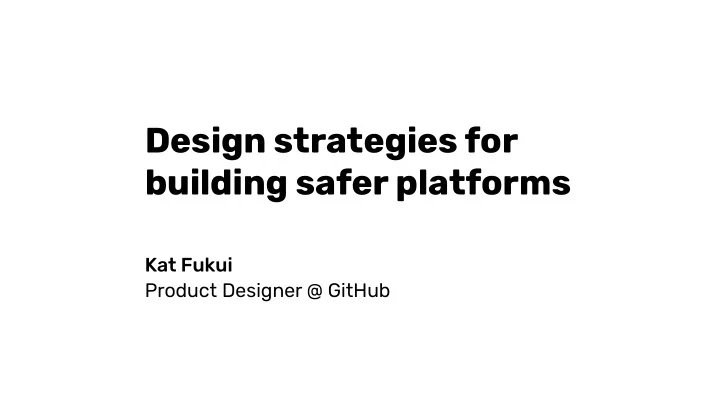

Design strategies for building safer platforms Kat Fukui Product Designer @ GitHub
💗 Kat Fukui Twitter: @katfukui GitHub: @katmeister Product Designer on the Community & Safety team at GitHub 💦 Comics 💂 Full-process design 💝 Internet communities
myoctocat.com/build-your-octocat
GitHub’s Community & Safety team builds systems that empower people to grow inclusive and healthy communities around their projects, while discouraging behavior that is destructive or threatens personal safety.
Building user safety into the foundation of technology we create is everyone’s responsibility .
Any platform or feature can, and will, be abused .
“ How could this feature be used harm someone?”
If users don’t feel safe on a platform, they will leave .
You don’t need to be a designer to incorporate design strategies that get your team collaborating on safer, inclusive, more consensual features.
💝 Understand with user stories Build with safety principles 🌊 Bridge with acceptance criteria 📞 Scale with documentation
We’ll learn about these design strategies through our lil friend, Blobbo!
Blobbo works on a B2B (blob to blob) platform. They’re working with their team to build a direct messaging feature.
💝 Understand with user stories
“users want private spaces to chat” “users want to be more social with friends and strangers” “users want to stay on our platform without switching to other chat apps”
Create user stories of stress cases * to better understand how your users are feeling in scary situations—like trying to escape abuse. *From Technically Wrong by Sara Wachter-Boettcher
18% of respondents have personally experienced a negative interaction with another user in open source, but 50% have witnessed one between other people. 21% of people who experienced or witnessed a negative behavior said they stopped contributing to a project because of it, and 8% started working in private channels more often. — Open Source Survey opensourcesurvey.org/2017
User stories are similar to user personas, but focuses more on their motivations and the context outside the screen — such as mental health.
What problems are they experiencing? How are they feeling ? What does success look like?
Abuser sends DMs from sock puppet User is trying to escape harassing accounts DM’s from an abusive relationship s s e l r e w o P Fearful + panicked
🖌 ✨ Draw together!
User stories are great for aligning your team on the feature’s vision , sharing specialized knowledge with other teams, and making quick decisions.
Build with safety principles
Define what safety means specifically to your users and create principles to guide you whenever making decisions. They can be aspirational!
At GitHub, user safety means ensuring everyone can participate in communities and collaborate on code without risking their privacy or personal well being, regardless of their background and identity.
Starter principles: Ask for consent 💭 Encourage inclusive behavior, discourage destructive behavior Minimize the impact of destructive content ❗ Leave a papertrail 🔎
💭 Ask for consent
Consensual software is software that asks for the user’s explicit permission to interact with them or their data. Consensual software respects users’ privacy and does not trick or coerce users into giving away permissions or data. Consensual software asks for permission first, rather than begging for forgiveness later. — Consensual Software consensualsoftware.com/what-is-consent
Asking for consent helps users feel in control of their experience on a platform. For actions that may leak private information (ex: their location) or exploit a user’s notifications , ask for consent so users can opt-in to features or workflows.
Consent-driven design also helps users make more informed decisions when interacting with other users, content, their personal data, etc.
Encourage inclusive behavior, discourage destructive behavior
Encourage behaviors that foster welcoming environments and helps participants of all backgrounds and identities to be productive without risking personal safety . Ensure there’s appropriate friction to discourage behavior that undermines productivity.
Encourage using trusted, “positive” GIFs
They’re new to the community!
❗ Minimize the impact of destructive behavior or content
Because any feature can be abused, include mechanisms to deal with unproductive content or users in the worst case scenario. Design a tier of tools ranging from least to most “nuclear” options.
Tools on the conversation level Tools on the content and user level
🔎 Leave a papertrail
Add internal audit logs , especially to help your Support team when they investigate abuse reports. Leave timeline entries in the UI to add context, especially in collaborative workflows.
🌊 Bridge with acceptance criteria
Acceptance criteria bridges the gap between design and engineering. By taking user stories and writing conditions for the features’ functionality, the entire team understands what workflows will be built.
📞 Scale with documentation
💝 Understand with user stories Build with safety principles 🌊 Bridge with acceptance criteria 📞 Scale with documentation
Let’s continue to prioritize humans in the technology we create, and work towards standardizing an open framework for the industry to build safer platforms.
Thank you! Twitter: @katfukui GitHub: @katmeister Email: kat@github.com
Recommend
More recommend